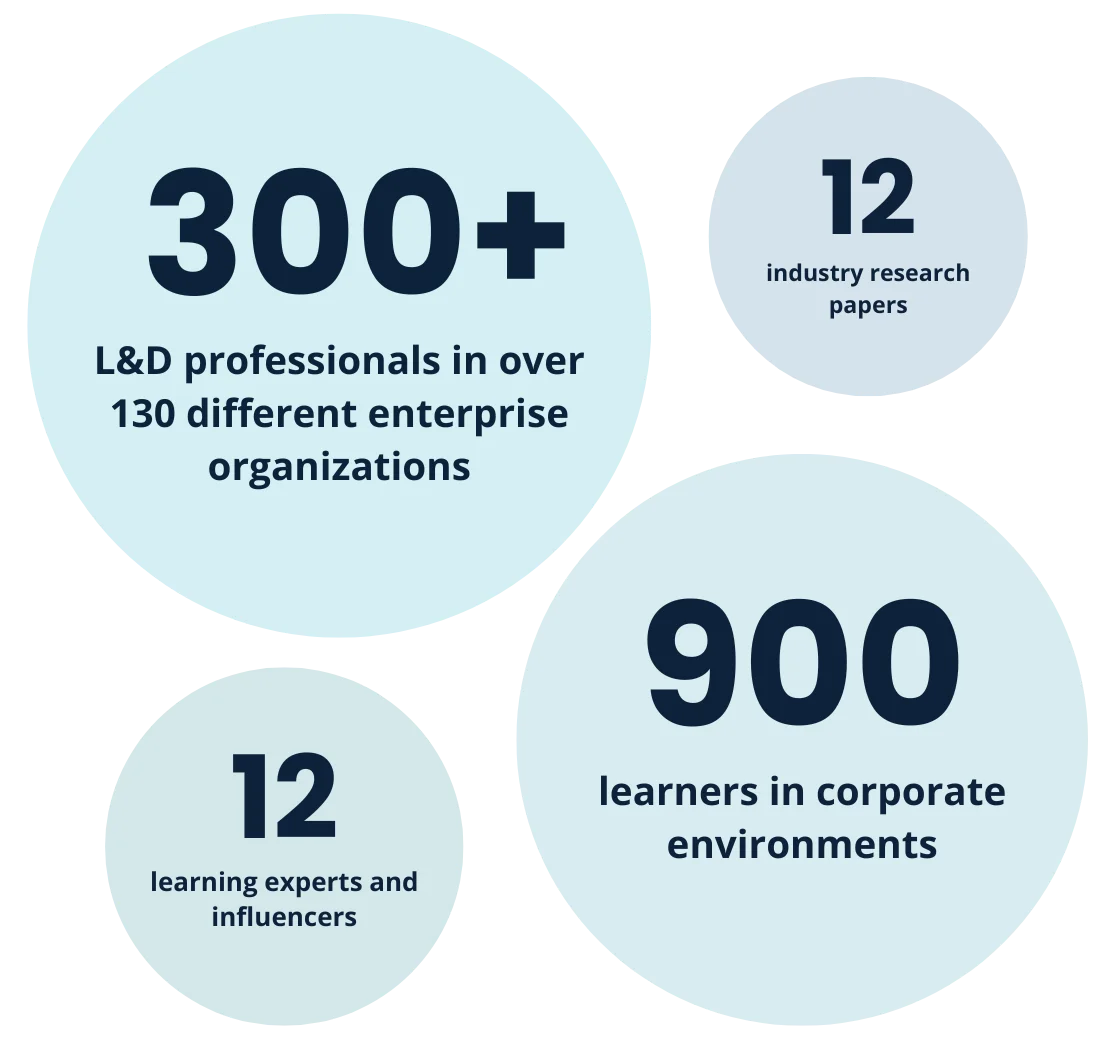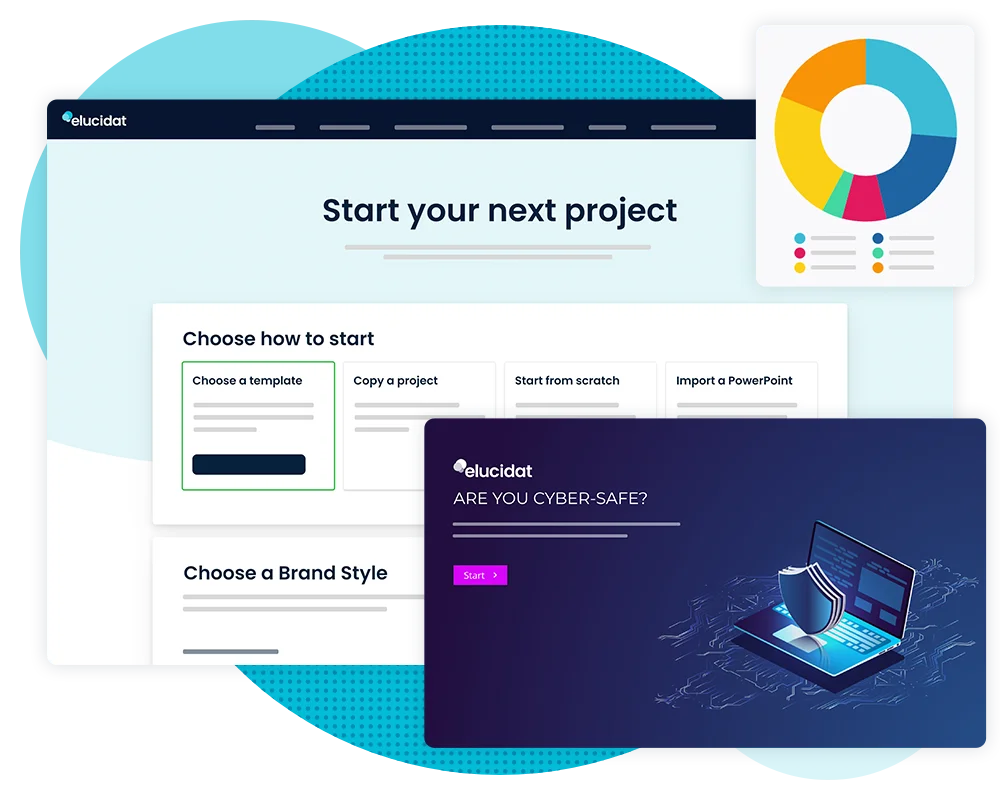
Introduction
In 2024 the digital learning landscape became a place of exploration. Learning and Development (L&D) got agile – working at pace to test out new tech, explore fresh approaches, and bridge skills gaps.
As we move out of this phase of experimentation and into 2025, what strategies have met organizations’ evolving needs? How is L&D using technology to deliver impact? What does impactful learning look like in the age of Artificial intelligence (AI), and how do internal experts play their part in producing it?
The State of Digital Learning Report aims to find out.
Our data
This report draws on the views of L&D leaders and experts who shape digital learning, as well as the employees who engage with it every day. Through a series of surveys, we gathered data and insights from:
We surveyed L&D managers & leaders in organizations with over 1000 employees in North America & Europe.

Our findings
We’ve analyzed this year’s research, compared the results with previous years’ reports, and distilled it down into key findings across five areas:
1. Current digital learning landscape
Explore the evolving challenges and opportunities L&D is facing.
2. Learner experiences and expectations
Discover what today’s enterprise learners want and whether they’re receiving it.
3. L&D success stories
Hear how some L&D teams are stepping up to deliver measurable impact.
4. Digital learning trends for 2025
Uncover the key trends that L&D professionals and experts predict will dominate in the year ahead.
5. Practical steps to stay ahead
Discover actionable ways to put these trends into practice and maximize your impact in 2025.
What could 2025 look like for you? Dive into this report that’s packed with peer insights and expert tips to find out.
Chapter 1
New challenges, big opportunities
The current digital learning landscape
Last year’s report saw L&D grappling with a digital learning landscape in a state of flux. From new technologies to shifting skills requirements, L&D had to stay agile and innovate to discover what worked in their organizations.
As we look to 2025, challenges and opportunities are coming into sharper focus. It’s no longer about just trying to keep up. It’s time to make informed decisions about the learning models, processes, and tech that will deliver at speed and scale, and with impact.
Let’s find out what this means for L&D professionals and experts.
What do your peers in L&D think?
We surveyed L&D leaders working in enterprise organizations across the world to explore what their digital learning landscape looks like.
What’s the current situation in L&D?
For 94% of learning leaders, digital learning is as important as ever to their overall L&D strategy. And despite financial uncertainty, they have investments to back this up. 90% of L&D budgets are staying the same or increasing.
How will your organizations overall spend on digital learning change next year?
Top priorities in 2025
The use of this budget will be concentrated on three priority areas:
- 65% want to improve quality and engagement
- 27% plan to increase capacity to scale up and respond quicker (a 7% increase from 2024)
- 7% will collaborate with the internal experts across the business
What challenges does L&D face?
Despite relatively stable levels of investment, over half of L&D leaders say that budget constraints are a critical challenge to implementing their digital learning strategies in 2025.
There was a significant increase in L&D teams who did not feel prepared for 2024, and this doesn’t look like it’s changing in 2025. 87% feel overwhelmed and under-equipped to achieve their priorities.
How well prepared do you feel?
L&D is being asked to tackle new and complex challenges with the same setup, exacerbating old struggles.
Most of the key challenges remain the same in 2025:
- Budget constraints (50%)
- Lack of capacity (46%)
- Technical limitations (37%)
- Resistance to change (33%)
- L&D skill gaps (28%)
But a new concern has appeared about digital learning:
- Content quality or volatility (23%)
Under pressure to respond to changing business needs and produce digital learning faster, L&D are conscious of what the future may look like for their top priority – the quality of their digital learning.
What is and is not working?
Being asked to get to grips with the explosion in AI tech, shifting skill gaps, and new processes with limited budgets, capacity, and capabilities clearly has an impact. L&D professionals highlighted what they feel has and hasn’t worked over the last year.
Quality is a key strength for L&D teams, but its importance also shows a growing focus as content creation speeds up. While it’s going well now, there’s a clear awareness of the challenge to keep quality high in the future. Balancing speed with impact will be crucial.
What’s working well for your organization?
What’s not working well for your organization?
Content
62% of L&D professionals say that relevant, interactive, and concise content is key to successful learning. 30% add that effective learning design boosts its impact.
Yet they’re seeing a big rise in content issues.
Top 3 problems highlighted:
- Content overload
- Lack of engagement
- Lack of relevance
See what some of our survey respondents thought…
Survey highlights
“We have high volume output but low quality.”
“We’re churning out volumes of content that are not maintainable.”
“We’re struggling to get Subject Matter Experts (SMEs) buy-in to simplify content.”
“We’ve got an overload of learning content with no curated journey – where to start and how to build skills.”
”We expect employees to be attracted to our learning library. But we don’t offer a ‘problem vs solution’ approach to help employees understand what’s in it for them.“
“We have mandatory training on topics which aren’t relevant for each department.”
Technology
16% of L&D professionals say new tech is helping them stay ahead.
Yet similar numbers continue to struggle to adopt this technology effectively.
Top 3 problems highlighted:
- Steep learning curves
- Delivering high-quality outputs
- Rolling out and integrating new tools
Let’s take a look at what some of our survey respondents said…
Survey highlights
“There’s quite a learning curve with new systems.”
“We are still struggling to collect and use analytics.”
“Artificial Intelligence (AI) content isn’t quite there yet in terms of quality.”
“I spend up to 20% of my time reviewing AI translated texts and videos to provide clear digital training to French teams. Even after months of use, we can’t see significant progress.”
“While we’ve made strides with digital tools, some of our systems and processes for content updates still require too much manual effort, slowing us down when quick changes are needed.”
Organization and processes
19% of those surveyed said effective collaboration and an agile response to change were working well for them.
However, a third of L&D professionals are struggling. The traditional challenges of needs analysis, content creation, measurement, and evaluation are evolving as AI, upskilling, and greater collaboration with Subject Matter Experts (SMEs) come into play.
Top 3 problems highlighted:
- Responding at speed and scale
- Deploying centralized, decentralized, and hybrid models effectively
- Meeting business needs and demonstrating impact
Let’s see what some of our survey respondents thought…
Survey highlights
“We’re struggling with the speed of digitizing content.”
“It takes too much time to develop, rollout and access digital assets.”
“It’s hard to keep everything up to date, especially with new requests constantly coming through.”
“We face challenges to rapidly update content in a highly agile environment.”
“The siloed approach doesn’t work in the long term to create elearning content. We need to work hand in hand with the SMEs.”
“Decentralization without the ability to control the activity and monitor collaboration is causing issues.”
“There’s not enough analysis of requests before we go about creating content.”
What do the experts think?
We spoke to leading L&D experts to get their perspectives on the challenges and opportunities those on the frontline face. Here are their thoughts on the current digital learning landscape and what it means for 2025.
Technology
Over the last year, businesses and L&D moved from ‘trying out’ to ‘rolling out’ new learning technology. Whilst every new tech comes with opportunities, it also comes with risk, especially if it’s adopted at high speed. Finding ways to avoid key pitfalls is critical for success in 2025.
Let’s see what the experts said…
Content
Over recent years, L&D has begun to recognize that just providing more online learning doesn’t lead to greater engagement or impact. However, the rush to reap the rewards of AI with rapid content creation means the risk of information overload is as relevant as ever.
Organization and processes
Faced with accelerated change, L&D needs solid foundations. From learning needs analysis to collaborative content creation, you can only deliver impact in 2025 if you have the right ways of working in place.
Faced with new challenges and significant opportunities, many L&D teams feel they lack the budget, capacity, and capabilities to deliver the impact businesses need. This shows up in three clear pain points: content issues, technology limitations, and inadequate processes.
But how are L&D struggles showing up in the end-user experience? Let’s find out what the learners think.
Chapter 2
Shifting needs, changing expectations
Current learner expectations
In today’s rapidly evolving workplace, employees face the same learning and development challenges as their L&D teams. As technology advances and agile upskilling becomes a priority, what do they need to excel in their work? And how do their learning experiences line up with these needs?
Only with a clearer view of your employees can you find ways to deliver impact for these learners and your business.
What do modern enterprise learners want?
We surveyed employees in enterprise organizations to explore how they engage with learning in their global corporate workplaces. Here’s what we found.
Meeting learning and development needs
79% of people are more likely to stay at a company if it invests in their professional development.
That lines up with LinkedIn Workplace Learning Report’s findings:
- 7 in 10 people say that learning improves their sense of connection to their organization.
- 8 in 10 people stated that learning adds purpose to their work.
However, this isn’t always happening for our learners.
Would you be more likely to stay at a company if it invests in your professional development?
Around a third of employees feel that their digital learning does not align, or only partially aligns, with the company’s overall goals and objectives.
Do you feel that your organization’s digital learning aligns with the company’s overall goals and objectives?
Three-quarters of employees feel that their digital learning isn’t entirely keeping up to date with industry changes and innovations.
While Fosway Digital Learning Realities reported that only 41% of learners say their organization’s learning platforms are fit for the modern workforce.
Do you feel that your organization’s digital learning approach keeps up with industry changes and innovations?
When we asked about upskilling or reskilling, employees recognized its importance on their careers. With skills relating to new technology the most in demand.
What skills would you most like to learn about to help you in your job?
Providing quality learning experiences
Employees are eager to learn and develop but aren’t always finding it easy. So, what can L&D do to change this picture and ensure more people get the learning they need to excel at work?
In a constantly changing landscape, the learners we surveyed remain consistent about what they want from their digital learning experiences.
Relevance
38% of learners want learning that can be easily applied to their work. However, two-thirds don’t feel that their digital learning is personalized to their role.
Here’s what our survey respondents said:
👍 When digital learning works it…
“Relates to my line of work.”
“Has something to do with what I do at work.”
“Enhances my job performance and gives me an edge over others within my company.”
“Provides information that’s relevant enough that I won’t forget it in a day or two.”
“Answers a problem I’m having.”
“Provides much needed information.”
“Helps me to be able to do my job.”
“Can actually be used for practical purpose – I can apply regularly and effectively.”
“Gives scenarios that are likely to happen.”
“Applies to our evolving industry.”
👎 When digital learning doesn’t work it…
“Doesn’t relate to my job.”
“Is redundant.”
“Doesn’t have any way to put it to use.”
“Is irrelevant and inefficient.”
“Feels pointless – repeats information I know or discusses irrelevant aspects.”
“Contains generic or obvious information.”
“Doesn’t help with what I do or what I was hoping to learn – skills I want to develop to advance in my career.”
“Means I have to keep looking for answers to my problem.”
“Doesn’t relate to what we’re doing as a company.”
“Isn’t tailored to my individual learning needs.”
Ease
Over half of employees say accessing online courses or resources at work is very easy. However, 44% of them use Google (37%) and AI (7%) as the go-to method to meet their learning needs. So, the accuracy and relevancy of their learning isn’t guaranteed.
Here’s what our survey respondents said:
👍 When digital learning works it…
“Is easy to find, access and navigate.”
“Has been incorporated into systems I already use.“
“Provides well-structured relevant sessions that are easy to find and lead to further learning.”
“Is made available to everyone in my team in the same place, at their own pace.“
“Feels seamless.”
“Makes it simple to move into and out of without losing my place.“
“Is easy to apply in the moment.“
“Can be self-paced.”
“Can be completed in less than 10 minutes.”
“Provides small amounts of learning at a time.”
“Is short, so I can get back to my busy work day.”
“Has been clearly communicated and is easy to understand.”
👎 When digital learning doesn’t work it…
“Glitches.”
“Has conflicting answers.”
“Contains too much information.”
“Takes too much time.”
“Takes a long time to complete.”
“Is difficult to access.”
“Feels outdated.”
“Involves reading long pages of information.”
“Takes too much time or doesn’t work correctly.”
“Is a waste of time and resources.”
“Feels like it’s overflowing with information.”
“Is hard to understand.”
“Involves clicking through screens to say I completed it, but not getting what I needed to know.”
“Provides fast-paced information that makes it harder to grasp.”
Quality
Just over a quarter of employees said their engagement increases when elearning is truly interactive. That’s when they have an opportunity to reflect on their knowledge and apply their skills.
Yet 57% of employees feel the overall quality of the digital learning resources provided by their organization could be improved. And just under half haven’t seen an improvement in the quality of their digital learning in the last year.
Here’s what our survey respondents said:
👍 When digital learning works it…
“Grabs my attention and makes me stay engaged with questions and other activities.“
“Sticks with me.”
“Is thought provoking.“
“Encourages interactive participation.”
“Feels interactive and fun!”
“Gives lots of great examples and context.”
“Provides information in a practical way using real-life scenarios.”
“Allows me time to practice what I’m learning.”
“Feels modern.“
“Provides exercises and quizzes so I can make sure I understand the material.“
“Is engaging and I feel I truly learn something from it.”
👎 When digital learning doesn’t work it…
Makes it easy to multitask and get distracted by other work, even if I think the learning topic is very important.“
“Becomes difficult to engage.“
“Lacks interaction.“
“Relies heavily on long texts or lectures without visual aids or multimedia elements.“
“Feels boring.“
“Looks dull, outdated and very, very bland. “
“Contains monotonous audio.“
“Lacks real-time feedback.“
“Fails to give opportunities for active participation, such as quizzes or discussions.“
“Feels isolating and uninspiring.“
Want to explore ways to meet learner expectations with relevant, effective, and quality digital learning?
Check out our elearning best practice guide and how to create engaging elearning course.
What is L&D doing to meet expectations?
Employees have enough on their plates without having to make time for ineffective elearning. That’s why many L&D teams have spent the past year exploring new tools and techniques to help them provide up-to-date and engaging digital learning experiences.
Here are the top three things L&D teams plan to take forward to deliver impact and meet learner expectations in 2025.
AI assistance
Just like employees, L&D teams are exploring how AI can help them meet learning needs at speed and scale. 91% of L&D professionals said they were considering or planning to use AI to assist with digital learning initiatives in 2025.
- 60% are looking to use AI to assist in content creation
- 11% see AI playing a significant role in personalization
- 11% want to use AI to assist with analytics and reporting
Common pitfall to avoid:
With the ability to produce digital learning faster than ever, L&D risks delivering content rather than impact.
Techniques to avoid it:
Avoid becoming a content provider by refocusing on what your business and learners need.
Skills management
Harnessing the right skills at the right time and for the right work is critical if employees and businesses are going to thrive. So, it’s unsurprising that, according to Fosway Digital Learning Realities, 78% of L&D professionals expect to use their digital learning platform for skills management in 2025.
Common pitfall to avoid:
Faced with fast changing skill gaps, digital learning can be out of date before it has even been delivered.
Techniques to avoid it:
Be a strategic partner in the shift to becoming a skills-based organization so you can deliver the right learning for your business.
Empowering internal experts
You can’t create a new digital learning landscape at speed and scale alone. It needs to be done in collaboration with others, and your internal experts are key. That’s why 26% of L&D professionals said that SMEs directly created over half of their digital learning projects.
Common pitfall to avoid:
SMEs are subject experts, not learning designers. Focusing on their content, rather than the learning outcomes, can lead to unengaging and ineffective elearning.
Techniques to avoid it:
From onboarding to reviews, a clear process – along with supporting tools and templates – will help your SMEs stay on track and deliver quality learning experiences.
Chapter 3
Meeting needs, delivering impact
L&D success stories
So, what does it look like to roll out these new tools and techniques effectively? We’ve spoken to three L&D teams working in different industries who have changed their ways of working to deliver real impact over the last year.
Here are their stories to get you inspired.
Aramex delivering engaging learning at speed and scale
Aramex has rapidly grown to become a global leader in transportation and logistics. To keep up with the pace of change and deliver the right learning, at the right time they needed to take their digital transformation to the next level.
With a new authoring tool and some upskilling, the L&D team was able to better meet the needs of the business and its international audience with an uplifted learner experience. Quick and simple AI auto-translation into a wide range of languages opened these engaging digital learning experiences to an even bigger global audience.
The results
- Delivering learning to 17,000 employees
- Across 42 countries
- Developing elearning 3x faster
To learn more about how to deliver at speed and scale, read Aramex’s full story.
Pret a Manger developing the skills employees need to thrive
At the heart of global retail food brand Pret a Manger’s success is a workplace where everyone can truly grow and thrive. Its Academy – a blend of face-to-face and online learning – supports employees at every level in achieving great things.
From increased employee engagement and retention to improved customer experience and sales, the Academy has delivered measurable results that any learning team would be overjoyed with.
The results
- Tracking key measures with analytics
- Driving real results demonstrated by KPI data
- Winning the prestigious Princess Royal Training Award
Want to find out more? Explore Pret a Manger’s full story.
Chapter 4
Shaping the future of L&D
Digital learning trends for 2025
The experimentation of 2024 has given us insight into what is and isn’t working for businesses and employees. As we move into 2025 and beyond, L&D professionals are building on these lessons, and new trends are emerging.
Top 10 trends for 2025
Here are the 10 corporate training trends L&D professionals and experts expect to see going to the next level in the coming year.
1. Meaningful AI
Leveraging new technology to deliver learning impact securely, ethically, and efficiently rather than just producing content.
2. Skills focus
Supporting the business in the shift from role-based structures to being a truly skills-based organization.
3. SME-generated content
Recognizing internal experts is more crucial than ever for accurate, up-to-date, and impactful learning.
4. Business priorities
Focusing on the foundations of learning impact: what the business needs and where critical skill gaps are.
5. Data analysis
Moving beyond traditional metrics and using advanced data analytics powered by AI to identify how learners interact and engage with content.
6. Personalization
Harnessing new digital technology to provide learning experiences that are truly personalized to role and preference.
7. Driving focus
Using your employee’s time wisely with learning that delivers results at pace.
8. Flow of work
Moving from training that feels like a separate task to learning that happens in real-time as a natural part of daily workflow.
9. People-centered
Avoiding losing sight of the reason you’re creating this digital learning: Humans.
10. Being agile
Staying nimble and responsive so you can continue identifying what works and adapting your approach.
3 key trends to pay attention to in 2025
Of this top 10 list, three trends were highlighted as critical by the vast majority of those surveyed.
Trend #1 – Meaningful AI
90% of L&D professionals surveyed see technology being the key trend shaping the future of digital learning in the next 3-5 years – with 80% highlighting AI’s role.
However, with 2024 seeing AI content quality, accuracy, and efficiency issues, it’s clear that how L&D uses this technology is the key to its success.
What technology trends do you see shaping digital learning in the next 3-5 years?
Trend #2 SME-generated content
SME-generated learning content is on the rise. 35% of L&D teams surveyed are using a hybrid mix of centralized (involving a core team of learning design experts) and decentralized (where learning is generated within departments or regions, sometimes without any learning design input). 27% are using a fully ground-up or decentralized L&D structure. How L&D and SMEs work together within these structures will be changing.
Trend #3 Skills focus
27% of L&D teams are exploring a shift from traditional job roles to a skills-based approach in the next few years. 21% are already making the shift or planning to do so soon.
As LinkedIn Workplace Learning Report has highlighted: tomorrow’s success requires skills agility. But most weighty learning initiatives stall at the planning and activation stages with fewer than 5% having advanced far enough to measure success. In 2025, this could change.
Chapter 5
Moving from ideas to impact
Practical steps to stay ahead in 2025
As we move from big ideas to real-world use, new technologies, approaches, and processes must come together to deliver business impact. What could this look like for you in 2025?
Other professionals and experts hope to turn our trends into practical actions in the new year by:
- Finding ways that roles can be augmented with AI.
- Leading the way by bridging skill gaps in L&D.
- Giving employees genuinely personalized learning.
- Developing a skills-based approach through data analysis.
- Exploring how new tech can support SMEs in developing effective digital learning.
Find out how you can do the same.
5 ways these trends come together to deliver impact
Let’s explore how to harness the full potential of these trends to deliver lasting results.
1. Augmenting roles with AI
With so many ways that AI could support your work, you need to be selective. Explore how this new tech can enhance L&D skills instead of replacing them.
Get ahead with this trend:
- Identify the day-to-day administrative tasks that could be completed by AI to free up you and your team.
- Recognize the tasks which require the human touch so you can focus your time where you have the most impact.
- Explore the parts of your work where human error can creep in and see if AI could be a second pair of eyes.
2. Taking personalization to the next level
Personalization always comes up on lists of what learners and L&D see working well in their digital learning. Advances in AI present an opportunity to take this a step further.
Get ahead with this trend:
- Outline the different ways that learning could be personalized in your organization, e.g. by role, department, or location.
- Identify the data available within your organization that could provide targeted learning experiences and development opportunities.
- From content searchability to chatbot coaches, explore the different ways that AI could help you provide personalized learning at scale.
3. Upskilling in L&D
The skill landscape has been evolving for everyone. If L&D is going to lead the way in upskilling or reskilling across their workplace, they need the right skills for the task at hand.

“It’s crucial that we not only upskill on the use of AI but also on soft skills, such as analytical thinking and problem-solving, to get the most out of AI. In the end, we want to aim for a human-machine partnership.”

Bianca Baumann
VP, Learning Solutions & Innovation, Ardent
Get ahead with this trend:
- Outline the current knowledge and skills within your team.
- Identify how your organization will use AI to determine the specific areas where you and your team will need upskilling and reskilling.
- Explore how your foundational L&D skills will be used and adapted in the new digital learning landscape.
4. Using data to move to a skills-based approach
The shift to becoming a skills-based organization is a big one. Don’t dive straight in. Explore your organization’s data to identify where you can make the right impact.
Get ahead with this trend:
- Make sure your organization is having a strategic conversation about skills – set by leadership and flowing through every department.
- Review the external skill landscape through government publications and industry reports.
- Get skill-mapping to align your digital learning with changing skill requirements.
5. Maximizing efficiency and minimizing disruptions for SMEs
In a world of AI, human expertise is more important than ever. Explore ways that tech can support your SMEs. Provide guidance, scaffolding, and support to maximize their impact.
Get ahead with this trend:
- Explore different approaches and define a process for how L&D, SMEs and AI can work best together in your organization.
- Create templates to keep SMEs and AI on track to deliver an effective and consistent learning approach.
- Encourage peer to peer support and the sharing of experiences, examples and best practice.
After years of experimenting with new tech and ways of working, 2025 is the time for L&D to settle on strategies that meet their organization’s needs. Which trends are you ready to take forward in the year ahead?
Conclusion
Putting it into action
Key takeaways for 2025 and beyond
The learning landscape continues to evolve, but 2025 will be a year of consolidation. Taking onboard the learning from the previous year’s experiments is critical to L&D’s success. Responding at speed and scale to fast-changing skills requirements while maintaining quality requires effective use of new technology, approaches, and processes.
L&D professionals and experts highlighted three strategies to help you drive effective learning at an enterprise scale in the year ahead.
1. Use AI meaningfully
From content overload to ineffective learning, 2024 saw the challenges of new tech coming into focus. But that isn’t a reason to take a step back. Instead, use technology with intention. Consider how it can help you achieve efficiencies and minimize disruption. Explore where it can augment roles and add value. Build strong L&D foundations to achieve the full potential of new technologies.
2. Refocus on skills
Faced with an ever-changing skills landscape, L&D should refocus on what they do best – supporting skills development. But remember, the shift to becoming a skills-based organization can’t be achieved by L&D alone. Collaborate to support the change rather than trying to lead it. Explore your organization’s data to understand where to focus your effort.
3. Empower internal experts
Experiments with AI have proven that SMEs are just as critical as ever. Checking content for accuracy. Bringing it to life with real-world stories. Creating that human connection. These are things that new tech just can’t do. L&D collaboration remains key to harnessing SME’s knowledge effectively, meeting rapidly changing learning needs, and delivering high-quality digital learning.
Put it into practice
Boost learner engagement, drive meaningful change and get certified with this interactive elearning course
Hear from learning experts every month
Subscribe to the Learning at Large Podcast to hear best practice tips from learning experts.
This report was produced by Elucidat. Elucidat is a multi-award winning elearning authoring platform chosen by the world’s largest enterprises for its unparalleled capability to enable them to deliver impactful and scalable learning experiences. To learn more about Elucidat’s authoring platform and how you can create unique, personalized digital learning, book a demo to get started.
Start your free trial
Start creating impactful elearning at scale with Elucidat

Resources
- Linkedin Learning – 2024 Workplace Learning Report
- Fosway group – Digital Learning Realities 2024
- Digital Learning Institute: The Future of Learning: What to Expect in Digital Learning in 2025
- Gallup State of the Global Workplace 2024
- Udemy Business: Global Learning & Skills Trends Report
- Raconteur Workplace Learning 2025
- Questionmark: L&D in 2025: from traditional to transformative
- Harvard Business Review: Reskilling in the age of AI
- Business Reporter: The new landscape of digital learning: 2024 and beyond
- World of Learning: Workplace learning and performance in 2024
- Open University: Trends in Learning 2024
- Great Place to Work: Learning & Development Report 2024







































